Rebuild & Recover – Two Producers Share their Experiences with Fire and Drought
For many beef producers across Canada, the past year was challenging because of environmental conditions. Many producers experienced and continue to withstand extreme weather, which is testing their production and profit potentials, but also their mental resolve and financial resilience.
When things aren’t going well, farmers may feel like everything is out of their control. However, thinking strategically, reaching out and building a community of peers and professionals can help producers navigate through tough times and come out stronger in the end.
Finding silver linings in the ashes
For Andrea Haywood-Farmer and her husband Ted, last summer they were running from one fire to another — literally. “Our whole ranch burnt except our homeplace,” Andrea says, yet she remains optimistic. “It was really scary. But we’re going to be okay.”
Wildfire is a primary risk for their multi-generational ranch, located near Savona, BC. The Haywood-Farmers run about 1,200 cow-calf pairs (collectively with a cousin) on fire-prone timber mountain range. “Fire can start anywhere and it can go anywhere, depending on the wind and conditions,” explains Andrea. “Not knowing where it might start or where it’s going is a significant vulnerability for us.”
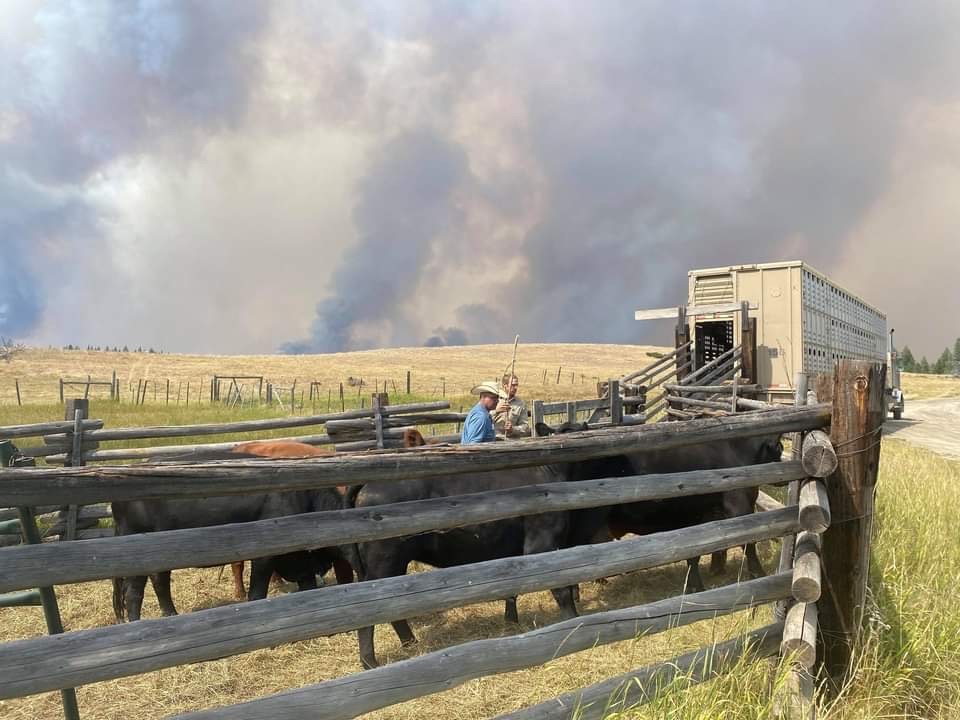
Where practical, they implement prevention practices. “There are things like your homeplace – you think about fire exposure and mitigating fire risk,” she says, and adds that they have hay fields strategically located around their yard for protection. When it comes to their range however, the uncertain nature of fire limits pre-planning. “You go and start opening gates and, to the best of your ability, if there are cattle in the pasture, you move them out of harm’s way,” explains Andrea. “And you keep doing it until you don’t have to do it anymore.”
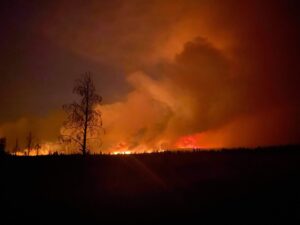
Andrea says the area had experienced 100 years of fire suppression. “A lot of forage had been choked out by forest grasses or trees growing into grasslands because we’ve lost our fire cycles,” she explains. “Ted and I have been saying for a long time that what we need is a low-intensity fire in April or October that could be managed,” she says. Prior to the wildfire, they had discussions with provincial range staff to arrange some prescribed burns. “We had candidate sites selected but the fire beat us to it,” she explains.
“Next year is tricky, there is some sensitive land we don’t want to graze,” she says, and adds they plan to move a portion of the herd to northern BC for the next year. “In the short term, you don’t have any forage. In the long term, it’s going to open up a lot of country for forage,” she says. “That’s an anticipated silver lining.”
Resilience of community
Haywood-Farmer said that a bright spot of the crisis was the overwhelming goodwill. “People are so awesome. We had ranchers, Indigenous communities, neighbours working together, 24 hours a day,” she recalls. If someone needed a hand, everybody showed up. “I felt like it was one of the most heartwarming things from a human perspective.”
She also said they had a good working relationship in place with public lands staff before the fire. “From Day 1, we were on the phone with range people who were checking in daily,” she adds. Communication remains essential as they work to determine a plan to go forward. “Operations stuff is already a full-time job, and on top of it we have to troubleshoot and figure out how to make the best business decisions,” Andrea explains. “The whole main part and infrastructure, corrals, water systems, those have all burnt,” she describes. Logistics like corral and fence replacement can occur over time but it’s a big effort. “We are grateful there is a path through, but it’s a heck of a lot of work to right the ship.”
To help manage animal health and welfare during the emergency, they leaned on their veterinarian to talk them through scenarios and help them make difficult decisions. “We have an amazing vet that Ted called up at 10:30 at night after a fire had just raked through and said, ‘I need some decision criteria, what is the decision tree on whether I give them a chance or put them down?’” Andrea explains. “It made Ted feel like he had a basis for his decisions,” she adds.
Wildfire & Forest Resources
More listed below.
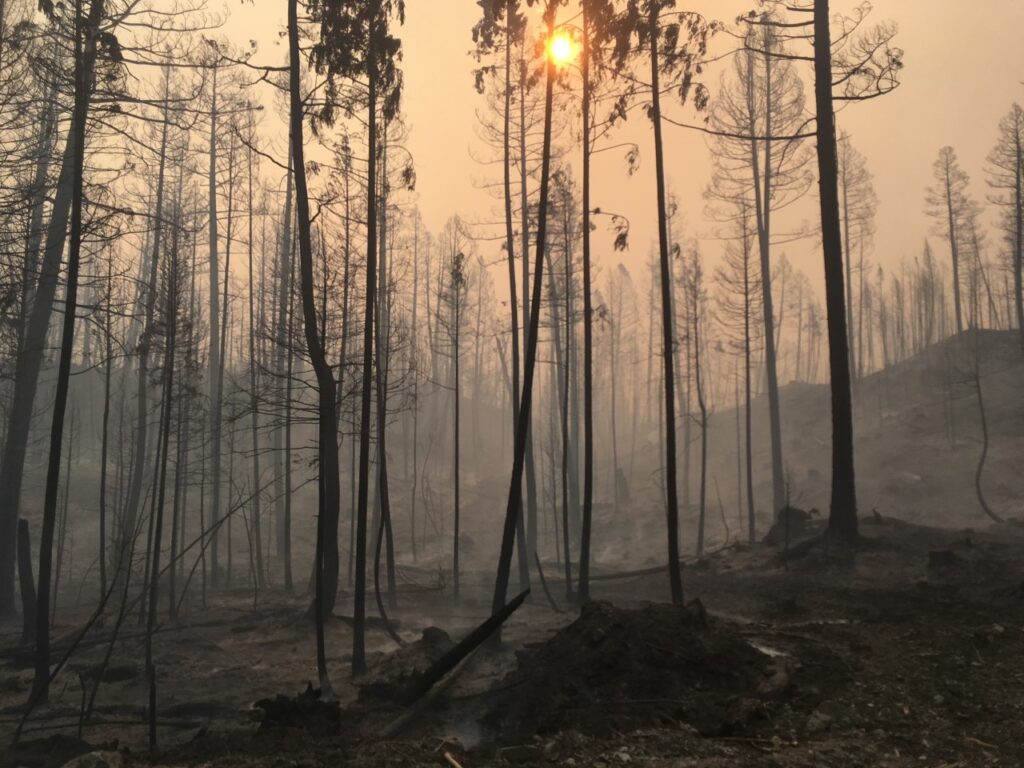
Rebuilding the land and its people is a marathon, not a sprint. Andrea says that support at the height of the crisis was valued and much needed, however the recovery phase is one of the most challenging times. “In the acute phase, the emergency phase, people are usually well supported, but during the rebuilding phase, it’s important to support people emotionally and mentally through that too,” Haywood-Farmer explains. “You don’t have that adrenaline; you don’t have all the people when you’re sitting at the computer and figuring out what the plan is for next year,” she says. “There’s an acute impact but also a lasting impact, and how do you buoy the ag community through that?”
Realizing the resilience of their community was a positive outcome for Haywood-Farmer, however she says looking ahead, beef producers are going to continue to face extreme environmental challenges. “It’s a new reality, it’s going to hit us all one way or another,” she says. “No one is immune to it.”
Planning for drought is planning for recovery
Larry Wegner is a beef and forage producer who farms near Virden, Manitoba, in an area he describes as a transitional soil type between parkland, mixed grasslands and tall grass prairie. “It’s basically been a four-year drought,” Wegner says of the past few years. Any moisture the area has received in the past growing seasons has been abnormal, either arriving off-season, or coming all at once and then not again for the rest of the year. “We definitely saw things happen that we hadn’t seen before,” Larry says, pointing out that there haven’t been any indicators that this current drought is done.
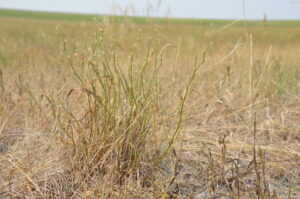
Wegner has been navigating the challenge by relying on his long-time planned grazing system where his herd grazes a series of smaller paddocks intensively, which are then rested for recovery. He estimates it takes 90 days for some of his tame species to recover, but on native pastures, the recovery period takes a full year or longer.
Wegner started planned grazing fifteen years ago after being prompted by another rough patch his farm sustained. “Back in BSE, we hit a dry year and the grass stopped growing after 45 days. I had a whole season ahead and ran out of moisture,” Larry says. “Every year we’re learning at it, no two years have been the same,” he says.
With their grazing management system, Wegner was able to increase carrying capacity of their land base prior to the dry years. “It’s about being adaptive and being able to change your herd numbers,” he says, and adds that custom grazing was a flexible way for their farm to increase stock densities and add an additional revenue stream. Part of their action plan to deal with the drought was being prepared to destock if necessary. “We knew if we didn’t get rain by a certain day, we were liquidating, which in our case was custom cattle,” Wegner says.
Maintaining pasture health is a priority for Larry. “We don’t want to abuse our land so it’s viable for next year. The worse the land suffers from a drought, the longer it takes to recover,” he explains. He adds that heavy grazing reduces residue and decreases the lands’ ability to capture and retain precipitation when it does rain. “Drought is like a bank account gone negative,” he says and, if you’re too far in debt, you’ll find it challenging to bank rainfall. “If you plan to go into a drought, your recovery will be quicker and easier.”
Taking stock of water, feed and genetic resources
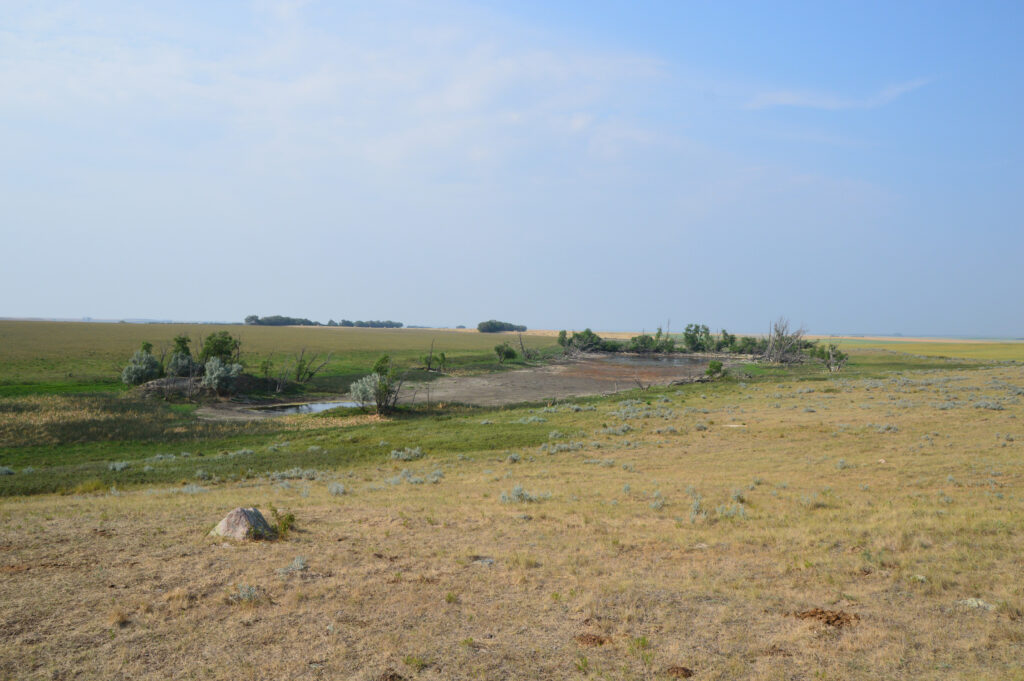
“Water quality was a big issue in late summer,” Wegner says, and adds that water supply remains a stumbling block for many this winter because the water table has dropped. “We had four dugouts go dry and dams go dry this summer,” he describes. In order to keep his cattle out of poor-quality water, they set up trails and pathways to allow their cows to walk farther home for fresh water. Looking ahead, Larry is considering adding a well system that would increase their flexibility for winter grazing.
Larry will supplement his herd in colder winter months with straw and pellets until his herd can head to stockpiled spring grazing in April. Sourcing supplemental feed comes with risk, however. “Every time you move feed you have to worry about what weeds are there to affect you,” Wegner says, and adds transport costs are also critical factors in dry years. “As much as you pay for feed for down the road you have to consider freight.”
Next year, Wegner is planning to convert some low-production pastures to annuals for added flexibility. “We will take two of our paddocks out that are just Kentucky bluegrass and smooth brome and stagnant and put annuals in there for feed or a polycrop that we can graze or supplement with,” Larry says.
Wegner explains that a key part of maintaining a cow herd through the drought is having the right kind of cattle. “Cattle are just a tool to harvest your forage,” he says, adding they carefully select replacement animals that will survive their management. During challenging years, that long-term focus has paid off. “The animals will tell you which ones adapt and which ones don’t.”
Drought Resources
- Resources for Drought Management
- Decision-Making During Drought
- Winter Feed Cost Comparison Calculator
More listed below.
It’s unclear if the drought is over yet for Wegner, but perseverance and adaptation will see him through. “We learn from our mistakes and from what we did right,” he says. “We don’t know unless we try things.”
Both producers shared helpful tips for dealing with immediate and long-term challenges:
- COVID-19 and farm-related worries have demonstrated that it’s important to talk to neighbours and fellow cattle producers. “We realized we do need connection. Reach out and say hi to your neighbours,” proposes Larry. Producers can also connect with one another and the BCRC through social media on Facebook or Twitter.
- Build and maintain solid relationships with extension staff and others in your network, says Andrea. “That translates into actually helpful things when you need it to.”
- Get a change of scenery. Larry says that getting off the farm, even for a drive, will bring some valuable perspective. “I’ll drive by another farm and think, ‘What’s he doing that I’m not?’ and learn from that,” he explains. See how other producers think outside the box and adapt to manage their on-farm challenges.
- In most provinces, there are government subsidy programs available to assist producers with financial hardship due to disaster. “They are good things to have in your back pocket so when you’re ready, you can use them,” says Larry.
- “Every producer needs to be thinking ahead in terms of what possible disaster implications are likely on your ranch,” says Andrea. “Obviously you can’t control all the variables, but think it through as a community,” she says. The BCRC has a wide range of production and financial calculators and tools that producers may find helpful when analyzing decisions.
- When situations are at their worst, focus on the positive. “People want to help,” says Andrea, “and these things bring out the best in people and neighbours become friends.”
Wildfire & Forest Resources:
- BC Cattlemen’s Association Wildfire Resources (Webpage)
- Wildfire Resources & Tools (Climate & Agriculture Initiative BC Webpage)
- Ranch Fire Safety Checklist (PDF file)
- Livestock Relocation (BC Government Webpage)
- Wildfires: Emergency Planning Resources (AgSafe BC Webpage)
- Grazing Forested Rangeland (BCRC Webpage)
Drought Resources:
- Resources for Drought Management (BCRC Webpage)
- Decision-Making During Drought (BCRC Blog)
- Winter Feed Cost Comparison Calculator (BCRC Blog & Tool)
- Experts Respond to Drought Questions (BCRC Blog)
- Water Systems for Beef Cattle (BCRC Blog)
- Test Stock Water & Reduce Worry (BCRC Blog)
- Plan to Adapt When Grazing (BCRC Blog)
- Decision Making Tools & Calculators (BCRC Tools)
Click here to subscribe to the BCRC Blog and receive email notifications when new content is posted.
The sharing or reprinting of BCRC Blog articles is welcome and encouraged. Please provide acknowledgement to the Beef Cattle Research Council, list the website address, www.BeefResearch.ca, and let us know you chose to share the article by emailing us at [email protected].
We welcome your questions, comments and suggestions. Contact us directly or generate public discussion by posting your thoughts below.